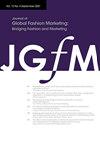Pro-environmental purchase intention towards eco-friendly apparel: Augmenting the theory of planned behavior with perceived consumer effectiveness and environmental concern
IF 5.5
Q2 BUSINESS
引用次数: 26
Abstract
ABSTRACT The textile industry has emerged as a major pollution source owing to a rise in carbon footprint, the spike in greenhouse gas emission, and increasing landfill waste. Sustainable fashion has become a new style statement and industries are shifting their orientation towards environment-friendly manufacturing. The theory of planned behavior (TPB) model was employed with environmental concern, personal moral norms, and perceived consumer effectiveness to better predict the eco-friendly apparel purchase intention of educated Indian youths. Variance-based partial least square-structural equation modeling (PLS-SEM) was applied to evaluate the hypothesized model. Findings indicated that perceived behavioral control has a strong significant positive influence on purchase intention followed by personal moral norms, attitude, and perceived consumer effectiveness. Environmental concern was found to have an indirect effect on purchase intention through three primary TPB variables and personal moral norms. Multi-group analysis (MGA) was performed to examine the moderating effect of perceived consumer effectiveness on an attitude–intention relationship. The highly perceived consumer effectiveness group was shown to have a more consistent attitude-purchase intention relationship as compared to the low-perceived consumer effectiveness group. The study promulgates insights to professionals and policymakers to formulate sustainable marketing strategies and policies to cope with the indigenous market conditions.环保服装的环保购买意向:用感知的消费者有效性和环境关注增强计划行为理论
摘要:由于碳足迹的增加、温室气体排放的激增和垃圾填埋场的增加,纺织业已成为一个主要的污染源。可持续时尚已经成为一种新的风格宣言,各行业正在将方向转向环保制造业。计划行为理论(TPB)模型结合环境关注、个人道德规范和感知消费者有效性,更好地预测受过教育的印度青年的环保服装购买意愿。应用基于方差的偏最小二乘结构方程建模(PLS-SEM)对假设模型进行评估。研究结果表明,感知行为控制对购买意愿、个人道德规范、态度和感知消费者有效性有显著的正向影响。环境关注通过三个主要的TPB变量和个人道德规范对购买意愿产生间接影响。进行了多组分析(MGA),以检验感知消费者有效性对态度-意图关系的调节作用。与低感知消费者效用组相比,高感知消费者效能组具有更一致的态度-购买-意向关系。该研究为专业人士和决策者提供了见解,以制定可持续的营销战略和政策,应对本土市场条件。
本文章由计算机程序翻译,如有差异,请以英文原文为准。
求助全文
约1分钟内获得全文
求助全文
来源期刊

Journal of Global Fashion Marketing
BUSINESS-
CiteScore
6.90
自引率
31.60%
发文量
34
期刊介绍:
The Journal of Global Fashion Marketing is a quarterly journal that publishes peer-reviewed conceptual and empirical papers and business cases of original works that significantly contribute to the overall advancement of marketing theory, research, and practice in fashion, design, and culture. JGFM endeavors to be a “global bridge” connecting marketing scholars and practitioners in fashion, design, and culture throughout the world. We publish high-quality scholarly articles on marketing written by contributors representing the leading academic authors. As we state on the cover of every issue, our positioning statement, our value added to the marketing scholar readership, is truly to “Bridge Fashion and Marketing” 1. Monitor and analyze global fashion marketing trends. 2. Generate and integrate new ideas and theories related to fashion, luxury, and culture marketing theory and practice. 3. Apply new research methods and techniques in fashion, luxury, and culture marketing. 4. Explore and disseminate cutting edge fashion marketing practices. JGFM welcomes manuscripts that provide fresh, innovative insight to any topic in the field of fashion, luxury, and culture marketing. Both conceptual and empirical works are valued, so long as the manuscript addresses substantive issues in marketing.
 求助内容:
求助内容: 应助结果提醒方式:
应助结果提醒方式:


